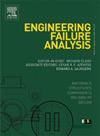Failure analysis on abnormal leakage current of power modules in the electric vehicle inverters
IF 4.4
2区 工程技术
Q1 ENGINEERING, MECHANICAL
引用次数: 0
Abstract
The efficiency and safety of electric vehicles depend significantly on the electronic control system and its critical components, especially the power modules in the inverter. The failure of the power module can pose a significant threat to the overall efficiency and safety of the electric vehicle. However, there is still limited in-depth research on the failure analysis of power modules. A comprehensive failure analysis of abnormal leakage current failure in power modules of electric vehicle inverters was conducted. Commissioned by an automobile company, material inspection and microstructural analysis were performed, and various failure modes and defects were systematically investigated. Ultimately, the root cause of abnormal leakage current in the power module was identified. Evidence shows that the cracking of the silicon nitride substrate inside the power module, caused by localized stress concentration, is the fundamental cause of the leakage current. Building on this analysis, potential issues in the design, manufacturing, and installation processes are further explored, and targeted improvement measures are proposed. The research findings provide crucial engineering guidance and technical support for enhancing the safety and stability of electric vehicle inverters.
电动汽车逆变器电源模块漏电流异常故障分析
电动汽车的效率和安全性在很大程度上取决于电子控制系统及其关键部件,特别是逆变器中的电源模块。电源模块的故障会对电动汽车的整体效率和安全性构成重大威胁。然而,对电源模块失效分析的深入研究仍然有限。对电动汽车逆变器电源模块异常漏电流故障进行了全面的故障分析。受某汽车公司委托,进行了材料检验和显微组织分析,系统研究了各种失效模式和缺陷。最终确定了电源模块漏电流异常的根本原因。有证据表明,功率模块内部的氮化硅衬底由于局部应力集中而开裂,是产生漏电流的根本原因。在此基础上,进一步探讨了设计、制造和安装过程中可能存在的问题,并提出了有针对性的改进措施。研究结果为提高电动汽车逆变器的安全性和稳定性提供了重要的工程指导和技术支持。
本文章由计算机程序翻译,如有差异,请以英文原文为准。
求助全文
约1分钟内获得全文
求助全文
来源期刊

Engineering Failure Analysis
工程技术-材料科学:表征与测试
CiteScore
7.70
自引率
20.00%
发文量
956
审稿时长
47 days
期刊介绍:
Engineering Failure Analysis publishes research papers describing the analysis of engineering failures and related studies.
Papers relating to the structure, properties and behaviour of engineering materials are encouraged, particularly those which also involve the detailed application of materials parameters to problems in engineering structures, components and design. In addition to the area of materials engineering, the interacting fields of mechanical, manufacturing, aeronautical, civil, chemical, corrosion and design engineering are considered relevant. Activity should be directed at analysing engineering failures and carrying out research to help reduce the incidences of failures and to extend the operating horizons of engineering materials.
Emphasis is placed on the mechanical properties of materials and their behaviour when influenced by structure, process and environment. Metallic, polymeric, ceramic and natural materials are all included and the application of these materials to real engineering situations should be emphasised. The use of a case-study based approach is also encouraged.
Engineering Failure Analysis provides essential reference material and critical feedback into the design process thereby contributing to the prevention of engineering failures in the future. All submissions will be subject to peer review from leading experts in the field.
 求助内容:
求助内容: 应助结果提醒方式:
应助结果提醒方式:


